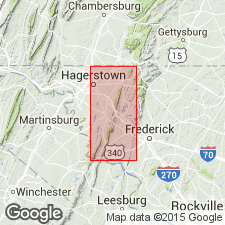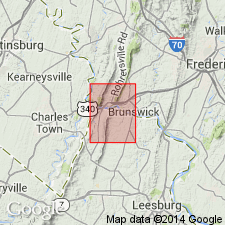
- Usage in publication:
-
- Benevola Member
- Modifications:
-
- Named
- Dominant lithology:
-
- Dolomite
- AAPG geologic province:
-
- Appalachian basin
Summary:
Named the Benevola Member of the Tomstown Formation for Benevola, Washington Co., MD. Unit extends from Jefferson Co., WV northward into southern PA. Consists of light-gray, massive, coarse-grained dolomite. Thickness is 60 to 150 feet. Overlies the Fort Duncan Member and underlies the Dargan Member, both of the Tomstown. Lower contact placed in 15-foot gradational zone with bioturbated dolomite of the Fort Duncan. Upper contact placed within a gradational zone of light-gray, thick-bedded to massive dolomite, alternating with thinly laminated dolomite (contact occurs where dolomite acquires a burrow-mottled to laminated appearance). The Benevola is of Early Cambrian age.
Source: GNU records (USGS DDS-6; Reston GNULEX).

- Usage in publication:
-
- Benevola Member*
- Modifications:
-
- Areal extent
- AAPG geologic province:
-
- Appalachian basin
Summary:
Geographically extended the Benevola Member of the Tomstown Formation into northern VA. In VA, WV, and MD, the Benevola consists of yellowish-gray to very light-gray and white, massive, pure, saccaroidal dolomite. Thickness is 25 meters. Overlies the Fort Duncan Member of the Tomstown, and is the youngest stratigraphic unit on the map.
Source: GNU records (USGS DDS-6; Reston GNULEX).
For more information, please contact Nancy Stamm, Geologic Names Committee Secretary.
Asterisk (*) indicates published by U.S. Geological Survey authors.
"No current usage" (†) implies that a name has been abandoned or has fallen into disuse. Former usage and, if known, replacement name given in parentheses ( ).
Slash (/) indicates name conflicts with nomenclatural guidelines (CSN, 1933; ACSN, 1961, 1970; NACSN, 1983, 2005, 2021). May be explained within brackets ([ ]).

